Opinion Pieces: The simple logic of getting people out of their cars and onto public transport

Opinion Pieces: since 2007, Prof. David Hensher has written an opinion column in the Australasian Bus and Coach magazine, where he monthly discusses a lot of different transport-related hot topics. In this section we are revisiting these columns.
September 2011
This opinion piece may well turn out to be the most ‘influential’ piece I have written since we started the monthly series in October 2007. The careful selection of words is quite a craft and one that begs indulgence to have maximum impact. During the Emerging Crises Summit on Cities, Population, Climate Change and Energy titled Moving People Solutions for a Growing Australia in Parliament House, Canberra (July 6 2011), I was on a panel gazetted for Road Pricing Reform. The Chair decided that Road Pricing is a long way off in terms of political agendas (despite all the lip service), and that we should focus our panel discussion on themes where we believe governments might be interested, and where they could make a difference in public transport reform.
I (and Bob Carr, former Premier of NSW) was asked to identify one very specific initiative that government’s could support (especially Federal Government) that could make a real difference to improving the performance of metropolitan transport systems.
My response, almost as if it had been brewing for many years, was to “flood the market with buses”. I connected this response to my earlier question (Opinion piece June 2011) – How many buses could the NW rail project in Sydney buy? Allowing for extra drivers, which has significant employment benefits, the current 4,000 buses operating in the Sydney metropolitan area, could be increased to at least 12,000, a three-fold increase in service capacity.
In anticipation of a loud yell of disapproval, I anticipated what the response would be. Specifically, people have told me that this would create a crisis on the roads with horrendous traffic congestion consequent on buses mixing with cars and trucks. My response is simple and accurate – if the real drivers of getting people out of their cars and into public transport are connectivity (the door-to-door element of travel, including integrated seamless multi-modal ticketing), frequency, regularity and visibility, which most would agree are the key factors, then a 300 percent increase in the service capacity of buses spread throughout the metropolitan area (or at least in areas where we believe public transport can make a difference), must surely result is some noticeable modal switching from the car, with a consequent positive impact on traffic congestion.
Given the substantial three-fold increase in service capacity, if this fails to make a dent on car use and hence traffic congestion, then what hope is there for any public transport initiative (be it new infrastructure and or new service levels) to contribute to reducing traffic congestion? Surely the failure of this initiative would send a signal about the disconnect between building the NWRail project (as one example of spending a lot of money on one narrowly focused project given the needs of entire metropolitan areas) and what it will do as a narrow corridor-specific initiative in impacting on traffic congestion (which I personally believe it will have very little impact).
I suspect that many politicians would agree with me, but so few if any would say so.
Food for thought
¿Comments? ¿Opinions? ¿Similar News? Send them to us!
Tweet
Tampa breaks ground on first bus rapid transit line

Source: Roads & Bridges
Tampa, Florida, USA, city officials broke ground on August for a new bus rapid transit line expected to open in spring 2013. The new line is part of the growing MetroRapid system, the city’s first BRT service.
Hillsborough Area Rapid Transit (HART) will oversee the project, which will connect downtown Tampa with Fletcher Avenue and I-75. The agency estimates that bus rapid transit will shorten the travel time of the 17.5-mile route by approximately 15 percent.
BRT would act as a viable public transit alternative to high-speed rail, a plan for which was vetoed by Gov. Rick Scott in 2011.
Funding for the project will largely come from the Hillsborough County Community Investment Tax. Monetary breakdown includes $31 million for design, land acquisition and construction; $1.75 million for a park-and-ride facility on Fletcher Avenue; and $2 million for transit signal priority, which allows buses to automatically get green lights at major intersections.
The north-south route will ultimately join up with an east-west line that includes Tampa International Airport and the Westshore Business District.
¿Comments? ¿Opinions? ¿Similar News? Send them to us!
Tweet
New Publication: Sustainable Development 2012-2050

Source: EMBARQ
Photos: Mariana Gil / EMBARQ Brazil.
More than a year ago, engineer Fernando Almeida began convening 19 experts in various fields of sustainability to publish Desenvolvimento Sustentável 2012-2050: Visão, Rumos e Contradições («Sustainable Development 2012-2050: Vision, Ways and Contradictions.») The collection was launched on June 15 in Rio de Janeiro. The book is marked by a transdisciplinary approach to issues such as environment, climate, economy, transportation, and others, all issues relevant to discussions on the agenda at Rio+20.
Between pages 175 and 193, the reader will find the chapter «Sustainable Transport in the Urban Century», by Director of EMBARQ Brazil and member of our Centre Luis Antonio Lindau, the former president of the World Resources Institute (WRI) Jonathan Lash, and political scientist Jacob Koch.
 The night-time launch was attended by Director of EMBARQ Holger Dalkmann, as well as EMBARQ’s Chief Operating Officer Clayton Lane, EMBARQ Brazil’s Director of Strategic Relations and Development Rejane D. Fernandes and former mayor of Bogotá (1998-2001) Enrique Peñalosa.
The night-time launch was attended by Director of EMBARQ Holger Dalkmann, as well as EMBARQ’s Chief Operating Officer Clayton Lane, EMBARQ Brazil’s Director of Strategic Relations and Development Rejane D. Fernandes and former mayor of Bogotá (1998-2001) Enrique Peñalosa.
Below is an excerpt from the conclusion of «Sustainable Transport in the Urban Century»:
Cities are at a crossroads in our battle against poverty, climate change and environmental degradation. We have a choice to make. We have before us two paths. The cities can be the engine of change and transformation and point the way towards a sustainable future; a life with low greenhouse gas emissions and continued prosperity. Or cities can lead to consumption patterns that pollute, irrevocably destroy and hurt our fragile planet and increase the gap between rich and poor.
The carbon footprint of people living in cities served by a system of high-density, mixed transportation is smaller than those living in regions that depend on the car to get around. They are also happier, richer and safer. Where you live determines your lifestyle and your environmental impact.
Are Brazilian cities ready to face the challenges and make the right choices for a sustainable future? Are they ready to compete with other cities in the world for international investments? Or will chronic lack of infrastructure prevent the expected growth? Will local governments obtain the technical capability and expertise to plan and implement complex transportation projects? Where will the next ideas to push the city forward come from? Who will propose the next innovation in sustainable transport?
The short-term thinking prevalent among politicians concerned with the next election will not be enough. Without the voice of the people demanding policy decisions promoting sustainable transport, it is unlikely that the current situation will improve.
Cities need to inspire a leadership dedicated to planning long-term sustainability to receive the permanent changes they need.
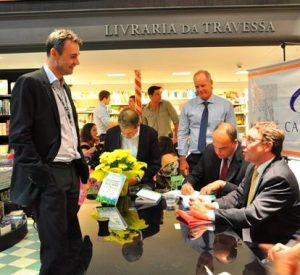

¿Comments? ¿Opinions? ¿Similar News? Send them to us!
Tweet
New Global Database on Bus Rapid Transit Launched
BRTdata.org provides most robust data to improve mobility and reduce carbon emissions from transit
Editor’s note: A webinar on the new brtdata.org database was held on Tuesday, April 10, at 12:00 p.m. EDT. Watch the recorded webinar here.
Washington (April 2, 2012) – Four global organizations have teamed up to launch the most comprehensive, public database of bus rapid transit (BRT) systems around the world. The new site, BRTdata.org, was created by the Across Latitudes and Cultures Bus Rapid Transit Centre of Excellence through EMBARQ, the World Resources Institute’s center for sustainable transport. The Database was created in collaboration with the International Energy Agency (IEA) and the Asociación Latinoamericana de Sistemas Integrados de Transporte y BRT (SIBRT).
BRT is one of the fastest growing public transport systems. Approximately 134 cities worldwide— from Bogota to Beijing— have implemented BRT systems or priority bus corridors, serving more than 22 million passenger trips daily.
BRT is a mode of public transport that flexibly combines stations, vehicles, services, running ways and intelligent transportation system elements into an integrated system.
“The new website provides reliable and up-to-date data to help researchers, transit agencies, city officials, and NGOs understand and make better decisions to improve BRT and bus corridors in their cities,” said Dario Hidalgo, member of ALC-BRT CoE and Director of Research and Practice, EMBARQ. “This is the first time that all of this publicly available data has been compiled in one place, but there is still more information available. We invite transit agencies and researchers to help us improve the knowledge base by sharing additional data to fill in the gaps.”
The new website allows users to compare BRT systems and bus corridors in all 134 cities in 36 countries. The database includes 95 different indicators on system operations, design and cost, including metrics like the number of passengers per day, commercial speed, and the length of corridors.
There is growing interest and demand for BRT as cities seek low-cost, sustainable urban transportation solutions. As the number of BRT systems increases, it is important to have current, accurate, and complete information about existing and planned systems.
The development of an online database was a joint data-sharing effort. EMBARQ and ALC-BRT CoE collected data mostly from Latin America, and the IEA contributed data from other regions.
“Previously, there was no single point of publicly accessible information about the worldwide BRT industry, and it was especially difficult to get an assessment of the industry’s size and how it was changing over time,” ALC-BRT CoE Director Juan Carlos Munoz said. “We finally have the right tools to set standards for this dynamic industry.”
Using information from this dataset, the IEA has estimated the energy and carbon dioxide (CO2) benefits of BRT implementation, and outlined several CO2-mitigation scenarios that rely in part on modal shift from light duty vehicles to public transit, including BRT. The IEA plans to recognize the extensive potential of BRT in its upcoming biennial report, “Energy Technology Perspectives 2012,” calling for the total network length of BRT systems to double by 2020.
“BRT is growing in importance as a transit alternative,» said Tali Trigg, energy analyst, IEA. «This database will be helpful to planners, and is an essential component in calculating energy efficient scenarios which inform decision makers of practical ways of transitioning to a more secure, sustainable and affordable energy future.”
Following are just a few examples of the data that is available from the new website:
- Worldwide, 129 new corridors have been implemented since 2000, and 37 since 2010.
- Latin American systems move more than 50 percent of global BRT daily passenger trips.
- 25 Brazilian cities have 87 bus corridors, totaling more than 560 kilometers– more than any other country.
- 18 of Asia’s 24 BRT systems began operations since 2006.
- Systems in 13 U.S. cities together carry nearly 600,000 passenger trips each day.
Watch a screencast tutorial on how to use new website.
¿Comments? ¿Opinions? ¿Similar News? Send them to us!
Tweet
Interview to Juan Carlos Muñoz and Darío Hidalgo (in Spanish)

This interview was held in the context of the CASPT12 conference held in Santiago on 23-27 July 2012. Juan Carlos Muñoz and Darío Hidalgo explained the relevance of the conference and the public transport systems of Santiago and Bogotá.
¿Comments? ¿Opinions? ¿Similar News? Send them to us!
Tweet
ITLS recognised for 21 years of achievement

Recently, The Institute of Transport and Logistics Studies (ITLS) of The University of Sydney, led by the Founding Director, and member of our CoE, Professor David Hensher, celebrated its 21st Anniversary. To learn more about ITLS and its 21 Years of Excellence, take a look at the video appearing below:
21 Years of Achievement – ITLS from THINKBOX on Vimeo.
Transport and supply chains are vital to the effective operation of our modern world. The Institute of Transport and Logistics Studies, located at the University of Sydney Business School, is dedicated to bringing about improvements within this important domain, by fostering innovation, and communicating best practice.
Internationally recognised as a leader in logistics studies, ITLS has forged partnerships around the globe, and regularly invites outstanding international scholars to teach and conduct research at The University of Sydney. ITLS also hosts a unique, regular global forum that provides an opportunity for academics and practitioners to come together and discuss contemporary transport issues.
Locally, ITLS is engaged with, and regularly drawn upon by the state Government, to provide research and advice for the provision of public transport services. Recent research on congestion charges and dedicated bus corridors have gained extensive media coverage.
The strong leadership and vision of Professor Hensher has much to do with the success of ITLS. In a relatively short time he has built a foundation which bodes well for ITLS achieving even great success in the future. Bravo and thank you to David and his colleagues!
Juan de Dios Ortúzar, also member of the CoE, was invited to the celebrations as a Keynote Presentation. His seminar title was: «Road pricing: An impeccable public policy – how can we sell it?». Here you can find David Hensher and Juan de Dios celebrating in Sydney:

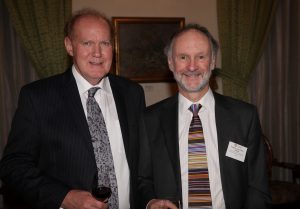
¿Comments? ¿Opinions? ¿Similar News? Send them to us!
Tweet
Video: interview to Juan Carlos Muñoz regarding Metro de Santiago (in Spanish)

In this interview, our director Juan Carlos Muñoz, analizes the solutions Metro de Santiago is implementing to ensure a good service, considering its current peaks in demand.
The interview was recorded on June 15, 2012, by Canal 24 Horas TVN, in Spanish.
¿Comments? ¿Opinions? ¿Similar News? Send them to us!
Tweet
Interview to Luis Gutiérrez in Latin Infrastructure Quarterly

Source: 4th Issue of Latin Infrastructure Quarterly LIQ4 – page 36 (Jul-Sep 2012)
LIQ Talks to Luis Ricardo Gutiérrez, EMBARQ Latin America Strategic Director and General Secretary of the Latin American Association of Integrated Systems and BRT (“SIBRT”)
Could you briefly explain EMBARQ and SIBRT?
EMBARQ’s mission is to act as a catalyst and help implement environmentally and financially sustainable transport solutions to improve the quality of life in cities. Since 2002, the network has grown to include five Centers for Sustainable Transport, located in Mexico, Brazil, India, China, Turkey and the Andean Region, that work together with local transport authorities to reduce pollution, improve public health, and create safe, accessible and attractive urban public spaces. The network employs more than 100 experts in fields ranging from architecture to air quality management; geography to journalism; and sociology to civil and transport engineering. SIBRT brings together Latin America’s most influential Integrated Transit Systems and Bus Rapid Transit (“BRT”) agencies. SIBRT facilitates the exchange of knowledge, produces “best practice” studies of the management, standardization, and operation of urban public transport, and proactively promotes Integrated Systems and BRT adoption as the safest, most efficient and sustainable form of mass transit. The Association is committed to quality urban public transportation development. SIBRT is present in 19 cities of 8 countries, which together comprise more than 95 million urban inhabitants. Its Associates provide public transit services to more than 20 million riders per day on more than 700 km of exclusive bus corridors (further information in www.sibrtonline.org). SIBRT was created in April 2010 with headquarters in Curitiba. EMBARQ acts as SIBRT’s General Secretariat.
What is the functional concept of BRTs and why are they interesting for Latin America.
BRTs are high-performance transportation solutions for urban corridors with elevated demand. BRT was conceived as an alternative to metros and light rails, which are more expensive, take longer to implement, and are less flexible than BRTs. BRTs, like railways, are one solution to sustainable urban public transportation challenges; they are an important part in managing the complex transportation needs of growing cities.
Continue reading the rest of the interview here (pg 36).
¿Comments? ¿Opinions? ¿Similar News? Send them to us!
Tweet
Development Banks Announce "Game Changer" for Sustainable Transport at Rio+20

Source: EMBARQ
The world’s largest multi-lateral development banks — led by the Asian Development Bank, the World Bank, and others — committed to provide more than $175 billion over 10 years to support sustainable transport in developing countries.
The announcement was made at the UN Sustainable Development Conference in Rio de Janeiro (Rio+20) by the African Development Bank, Asian Development Bank, CAF- Development Bank of Latin America, European Bank for Reconstruction and Development, European Investment Bank, Inter-American Development Bank, Islamic Development Bank, and the World Bank.
Following is a statement from EMBARQ’s director, Holger Dalkmann:
«This is a game changer for sustainable transport. It will ensure that hundreds of millions of people will have cleaner air, less congested roads, and safer transportation.
Ten years ago transportation wasn’t even in the discussion; now it’s a major outcome from the world’s preeminent conference on sustainable development.
Banks are putting their money where it matters — on streets built for people, not just cars. The world’s population is expected to surpass 9 billion by 2050, with more than half living in Asia, mostly in urban areas. At the same time, the rate of vehicle ownership is predicted to skyrocket from around 800 million cars a decade ago to around 2 billion in 2030. These two mega-trends are coming together to create an environment where people must compete for financial, institutional, and physical resources. In response, we need better urban designs; more sustainable transportation modes, like walking, biking and mass transit; and improvements in existing vehicle and fuel technology.
This investment is not just about improving the way people move from point A to point B; it’s also about providing access and mobility for the poor and improving road safety, not to mention reducing transport-related greenhouse gas emissions. Transport is no small piece of the climate change pie: the sector represents approximately one-quarter of global CO2 emissions.
Today’s announcement will no doubt encourage other decision-makers, especially national governments, to consider financing transport projects based on social and environmental benefits. It will push sustainability into the core of urban development.
At the same time, we need to make sure that the money gets invested into the right kind of projects, and that there are sound mechanisms to measure its impact. This will require full transparency and independent monitoring.
Countries often invest in transportation and infrastructure, but much of that goes into highways. We need to be smarter about where money flows, whether that means creating vibrant public spaces, providing safer infrastructure for pedestrians and cyclists, or building high-tech, low-cost transit systems. Doing this would be a paradigm shift in the way we finance the growth of sustainable cities, similar to what the Asian Development Bank has done with its Sustainable Transport Initiative, a lending and technical assistance program for transport projects in Asia and the Pacific that emphasizes inclusive economic and environmentally sustainable growth.
EMBARQ, the World Resources Institute’s center for sustainable transport, is a founding member of the Partnership on Sustainable Low Carbon Transport, which helped to catalyze this new financial commitment by the banks.
Years from now, we may look back at Rio+20 as the moment when transport was pushed to the top of the sustainability agenda.”
¿Comments? ¿Opinions? ¿Similar News? Send them to us!
Tweet
Rio de Janeiro Opens Transoeste, the City’s First Bus Rapid Transit Line

Source: EMBARQ. This post was originally published in Portuguese on EMBARQBrasil.org.
Photo: Mariana Gil / EMBARQ Brazil. The new buses serving the Transoeste line, known as Ligeirões hold over 140 people
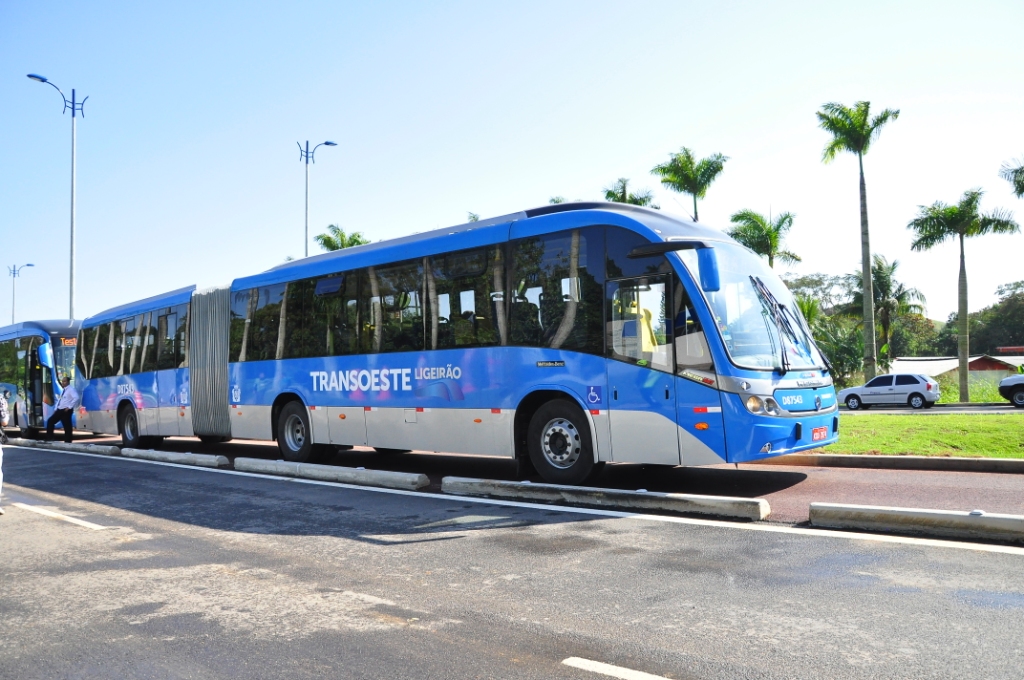
As world leaders gathered to address global sustainability at the Rio+20 Conference, the summit’s host city, Rio de Janeiro, just undertook its own green initiative— it launched its first bus rapid transit (BRT) corridor.
The lives of millions of cariocas, Rio de Janeiro residents, have already started to change with the opening of the Transoeste, the city’s first BRT corridor. The public transit system, developed with assistance from EMBARQ, expects to help hundreds of thousands of Rio residents, providing them with safer transport, shorter commutes, and less pollution.
“Today is a Great Day”
Mayor Eduardo Paes made the official announcement on June 6 at Pingo D’Água station in Guaratiba, West Zone, alongside former Brazilian president, Luis Inácio Lula da Silva, and Rio’s governor, Sergio Cabral. The director of EMBARQ Brazil, and member of our CoE, Luis Antonio Lindau, also took part in the event, strengthening the partnership between the organization and City Hall.
“Today is a great day,” said Lindau at the event. “Rio de Janeiro begins a new era of quality, efficiency and safety in Brazilian transit.”
EMBARQ Brazil, with support from Bloomberg Philantropies, has provided technical support to Rio’s City Hall through road safety audits, a crucial step to reduce the risk of traffic crashes on the corridor and to save lives. Partners also worked on several other actions to establish the first BRT in Rio.
The buses, nicknamed Ligeirões (meaning “super fast” in Portuguese) started to circulate on an experimental basis on June 6. During this first stage, which lasted until June 23, nine stations and 11 buses were operating off-peak, between 10:00 a.m. and 3:00 p.m. Other stations will gradually become operational.
Beginning in August 2013, when the system will become fully operational, the BRT will have an extension of 35 miles (56 kilometers) and 64 stations, with waiting times between buses of approximately one-and-a-half minutes. The system is estimated to benefit about 220,000 people each day, with most journeys being more comfortable and half as long as pre-BRT commute times.
Plans for the Future
Rio transporation officials plan on expanding the BRT system in the future, from one corridor to four. In total, 93 miles (150 kilometers) of BRT lanes will be built, changing mobility all over the Cidade Maravilhosa (Rio’s nickname, which means “wonderful city” in Portuguese).
«This is the first BRT, with others to come,” said Mayor Paes. “It is a cultural change around how people move about in the city. It’s like a subway train on wheels, at much lower costs.”
The four total corridors will include:
- Transoeste: An express bus corridor that will connect Barra da Tijuca to Santa Cruz and Campo Grande. The Transoeste will be 56 kilometers long and comprise 64 BRT stations. The average journey times are expected to be reduced by one-half on this lane. The first stage of the project is already operational on a trial basis and should be completed by August 2013.
- Transcarioca: The Transcarioca will be the first high-capacity corridor crossing the city transversally and connecting Barra da Tijuca to the international airport at Ilha do Governador on an exclusive, 24-mile (39 kilometer) lane. It is estimated that around 400,000 people will benefit daily from the system.
- Transolímpica: The 16-mile corridor (26 kilometers), connecting the neighborhoods of Deodoro and Barra da Tijuca via the Transolímpica, will be more than a way of shortening athletes’ journey times between the venues of the 2016 Olympic Games. Unlike the other three corridors under construction, this one will also be an expressway for cars, with no crossings or traffic lights, similar to Rio’s Linha Amarela.
- Transbrasil: This will be the fourth corridor to be built by Rio’s City Hall in time for the 2016 Olympic Games – 20 miles (32 kilometers) long and comprising 25 stations. This line will connect the Santos Dumont airport to Deodoro in the city’s West Zone, and will have the biggest demand of all, with 900,000 commuters per day. It will have connection points with the Transolímpica and the Transcarioca, as well as stations at Francisco Bicalho and Presidente Vargas avenues.
¿Comments? ¿Opinions? ¿Similar News? Send them to us!
Tweet
Event wrap up: 12 International Conference on Advanced Systems for Public Transport CASPT12

The twelfth version of the International Conference on Advanced Systems for Public Transport was held in Santiago, Chile from July 23 to July 27, 2012. This time the conference was organized by the Department of Transport Engineering and Logistics of the Pontificia Universidad Católica de Chile, with the support of the Bus Rapid Transit Centre of Excellence. This conference has become the most important in the field of design and operations of public transport systems. For the first time it was organized in the southern hemisphere and in a Latin American city.
For almost 40 years CASPT has served as a forum for the international community of researchers, practitioners and vendors involved on all aspects of public transport planning and operations (with similar emphasis in bus and rail based services). CASPT covers significant contributions to the theory and application of systems and methodologies for advancing public transport planning and operations. CASPT encourages not only the generation and presentation of new ideas, but also hopes to instigate productive collaborations between participants from academia, industry, and government.
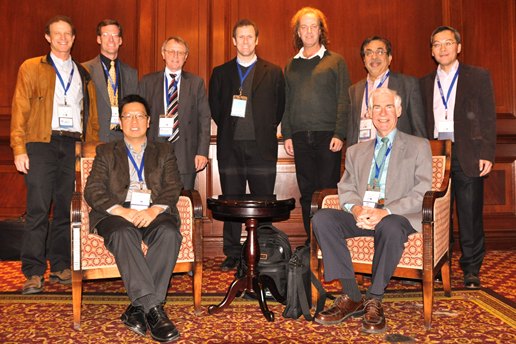 Traditionally, this conference attracts participants from many countries, most of them in North America or Europe. To increase its regional impact in South America, CASPT was organized in parallel to a meeting of the Latin American Association of Integrated Transit Systems and BRT (SIBRT) which guaranteed the participation of members of the most important transit agencies and operators of Latin America.
Traditionally, this conference attracts participants from many countries, most of them in North America or Europe. To increase its regional impact in South America, CASPT was organized in parallel to a meeting of the Latin American Association of Integrated Transit Systems and BRT (SIBRT) which guaranteed the participation of members of the most important transit agencies and operators of Latin America.
The call for extended abstracts received around 180 contributions. They came from over 30 countries from the 5 continents. By the end, 92 papers were presented, plus 7 plenary talks (3 by local authorities at the inauguration) and 15 talks at the SIBRT meetings. The following were the plenary talks:
- Urban Public Transport Policy in Chile – Pedro Pablo Errázuriz, Minister of Transports and Telecommunications of Chile
- Challenges of improving and expanding the Metro in Santiago, Chile – Roberto Bianchi, Chief Executive Officer Metro de Santiago
- Transantiago, a radical transformation: yesterday, today and tomorrow – Patricio Pérez, General Coordinator of Transantiago
- Urban Transport: A little less conversation, a little more action – David A. Hensher, Institute of Transport and Logistics Studies, The University of Sydney, Australia
- On Joint Rail and Property Development: Opportunities and Potential Pitfalls – Hong K. Lo, Hong Kong University of Science and Technology, China
- Traffic congestion in networks, and alleviating it with public transportation and pricing – Carlos Daganzo, University of California, Berkeley, USA
- Sustainable Transportation: Just a question of mode technology election? – Paulo Custodio, Private consultant, Brazil
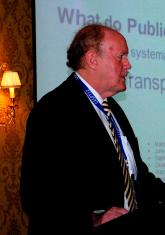

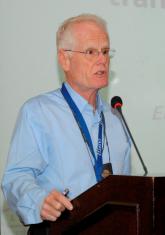
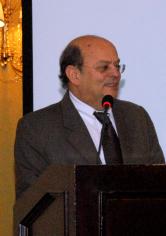
We had a bit over 250 attendants from 33 countries to the meeting (Australia, Brasil, Canada, Chile, China, Colombia, Denmark, Ecuador, Egypt, France, Germany, Hong Kong, Hungary, Iran, Ireland, Israel, Italy, Japan, Mexico, Netherlands, New Zealand, Peru, Portugal, Serbia, South Africa, Spain, Sweden, Switzerland, Taiwan, Turkey, UK, US and Uruguay) during the five days event, which included a Welcome Cocktail, a day trip to Casablanca Valley and Valparaíso, a Conference Dinner at the San Cristóbal hill and Technical visits in Santiago.
Additionally, the opportunity was taken for organizing a fair of software providers for managing, designing and control of public transport systems, as well as an open half-day Workshop between operators, academics, agencies and providers, where the firms had the opportunity to make a presentation about the products and services they offer. We had 7 firms presenting their products and services, and then a roundtable to discuss about them from a Latin American perspective. Around 60 people from firms, agencies, operators and academia attended it.
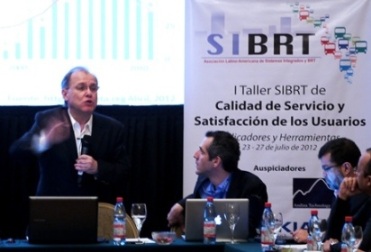
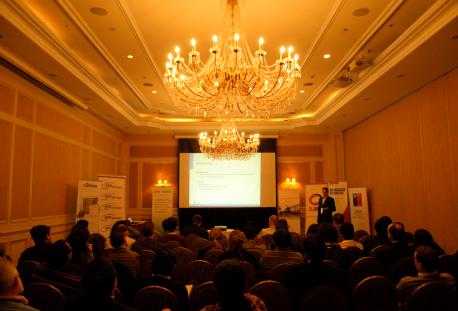
¿Comments? ¿Opinions? ¿Similar News? Send them to us!
Tweet
First SIBRT Service Quality and User Satisfaction Workshop

A Major Step in Latin America Towards High Quality Public Transportation for All
 The First SIBRT Service Quality and User Satisfaction Workshop, organized by SIBRT with the support of Transantiago, our ALC-BRT Centre of Excellence, and the EMBARQ Network, brought together more than 40 participants from 12 cities and six Latin-American countries to discuss how to offer high quality public transportation services and achieve user satisfaction. The event took place from July 23-27 in Santiago, Chile during the Conference on Advanced Systems for Public Transport, CASPT12.
The First SIBRT Service Quality and User Satisfaction Workshop, organized by SIBRT with the support of Transantiago, our ALC-BRT Centre of Excellence, and the EMBARQ Network, brought together more than 40 participants from 12 cities and six Latin-American countries to discuss how to offer high quality public transportation services and achieve user satisfaction. The event took place from July 23-27 in Santiago, Chile during the Conference on Advanced Systems for Public Transport, CASPT12.
The exchange of experiences is part of the growing and systematic benchmarking work underway by SIBRT, which was inspired by the precursory experiences of the Railway Technology Strategy Centre – RTSC of the Imperial College of London. This benchmarking work is being done in cooperation with our Centre of Excellence, which contributes scientific expertise to SIBRT. This cooperation was critical to ensure that the SIBRT Workshop in Santiago achieved world class quality.
“We need to recognize the contributions of visionary Professor Juan Carlos Muñoz, who leads the Center of Excellence, and the amazing work of his team of researcher from PUC Chile, and recognize the methodological guidance provided by Professor Luis Antonio Lindau, the President of EMBARQ Brazil, for opening a fruitful space for exchange and cooperation between the different actors that are responsible for providing quality public transportation services” asserted Luis Gutiérrez, Strategic Director for Latin America for the EMBARQ Network and General Secretary of SIBRT.
The discussions took place through SIBRT agency presentations and group dynamics covering each one of the three critical themes: managing user opinions, performance indicators and contractual mechanisms. The workshop permitted the agencies’ technical staff to learn about the point of view of the private operators from Colombia and Mexico and also from some transit suppliers, which added to the analysis that was being done in the small groups.
The work was led by André Jacobsen, SIBRT Benchmarking Expert, with the help of four professional facilitators that recorded all the ideas and suggestions expressed by the participants, so as to later synthesize all of the information and discussions from the workshop.
The closing session of CASPT12 served as another fruitful milestone for our work in Santiago. Public transportation supplies of planning, information, and management technology and software presented on their products to an audience of transit managers, operators, experts and consultants which led to a valuable and an acute discussion on the future of the industry and the services needed in the transit sector. SIBRT presented its vision on the modernization challenges facing public transportation providers in Latin America y the need to work together through strategic alliances. In this way, CASPT12 became a privileged setting for dialogue and cooperation between different transit sectors that had not come together in this format before. “We are very pleased with the work that occurred in this final meeting…Suppliers, managers, and operators were, for the first time, the protagonists of a process of exchanging experiences and concepts that were very constructive and creative, that we hope to see repeated in the future…Our Center will be ready to repeat this process as many times as is needed…”, said Juan Carlos Muñoz.
The knowledge gathered in the First SIBRT Service Quality and User Satisfaction Workshop will serve as the basis for the realization of a common strategic agenda. SIBRT, the Center of Excellence, and the EMBARQ Network have agreed to develop studies and guides of best practices that support all those involved in public transportation systems in Latin American cities so that they will have the opportunity to improve their capacity and implement services with the highest quality standards.
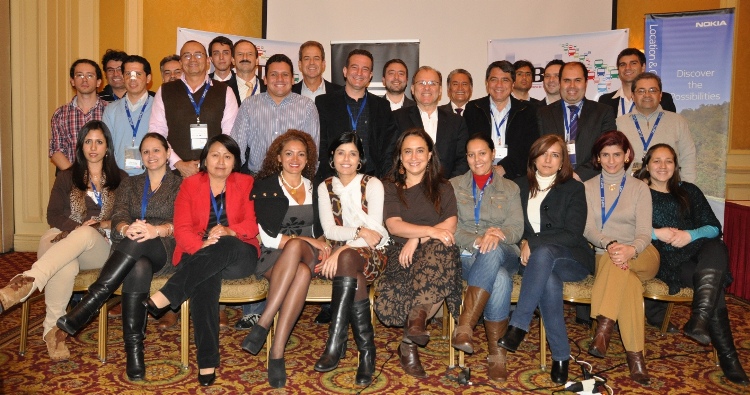
¿Comments? ¿Opinions? ¿Similar News? Send them to us!
Tweet
Traffic Safety on Bus Corridors: Pilot Version – Road Test

Source: EMBARQ
The purpose of this guidebook (launched a couple of months ago, as described here) is to provide bus agencies, local jurisdictions, as well as regional and international organizations with a set of suggested design, planning, and operational criteria that should be considered in the planning and design of new bus systems.
The information contained in these guidelines should by no means be used as standard details on which to base a final design, but rather as recommended criteria and general guidance which, in conjunction with engineering judgment and a thorough analysis of existing conditions on the corridors, should help develop final designs. Moreover, these are global guidelines representing general concepts and are not site or country specific, and they may not always be adapted to local design and signalization standards. The applicable local standards for signalization and markings should always be checked before applying the recommendations set forth in these guidelines.
EMBARQ will distribute the pilot version of the guidelines, available in English, Spanish, and Portuguese, to people involved in the planning and design of new bus corridors, including experts who work at multilateral development banks, government institutions, transit agencies, universities and transport consultancies.
To become involved in the “road test,” please contact EMBARQ Transportation Research Analyast Nicolae Duduta at nduduta@wri.org to receive a copy of the guidebook, as well as instructions on providing feedback.
Download full report:
English
Español
Português
¿Comments? ¿Opinions? ¿Similar News? Send them to us!
Tweet
Getting from A to B with less stress – David Hensher video

Source: What matters to you?
What matters to you? is a website developed by The University of Sydney, which publishes polls and compiles the opinions of the visitors who have chosen to participate in them.
One of the matters presented in June 2012 was «Getting from A to B with less stress», and a video with David Hensher was developed to address this matter. It is described as: David Hensher is developing ideas to improve public transport and reduce traffic congestion on our roads. In addition to the obvious environmental benefits, these changes will improve people’s lifestyles and productivity.
¿Comments? ¿Opinions? ¿Similar News? Send them to us!
Tweet
Event Wrap Up: Transantiago and Metrobús – How to achieve social sustainability?

Profoundly reforming an urban transportation system is as complicated as trying to rebuild a house with the residents inside. Despite all the shortcomings accompanying the status quo of many urban transportation systems today, both the transportation operators and the users have adapted to the market conditions within which they operate, such that any change must proceed with caution. In other words, grand plans to improve public transportation in our cities must search for a balance between the technically desirable and the politically feasible. Putting all the emphasis on only one side (e.g., the technical) can derail reform, or weaken it to the point where the desired results are not realized. Although certainly not the only ones, two critical aspects to consider in the search for this balance are: the way in which reformers approach negotiations with existing operators; and the way in which they communicate with, and open up to the participation of civil society, more generally. Both aspects influence not only the feasibility of implementing reform but also the sustainability of the system once reformed.
In this context, our Centre of Excellence, together with the Institute of Sociology of the Pontificia Universidad Católica de Chile and MIT’s Department of Urban Studies and Planning convened a diverse group of academics, authorities, operators, and members of civil society to discuss and share lessons from the implementation of Transantiago, in the Chilean capital, and Metrobús, in the Mexican capital. The evento took place on Thursday, 31 May at the Pontificia Universidad Católica de Chile, in Santiago, and was inaugurated by the Chilean Minster of Transportation and Telecommunications, Pedro Pablo Errázuriz.
The design of the event aimed to focus on discussions rather than formal presentations. In the morning, authorities and operators from both cities spoke at a roundtable moderated by Professor Christopher Zegras, from MIT. Private sector participants included: Jesús Padilla, President of Corredor Insurgentes (the principal private operator of the Metrobús system), and Simón Dosque and Hector Moya (Managers of Transantiago’s Buses Vule y Subus Chile, respectively). Authorities included Jorge Rocha, Director of Planning and Evaluation of Metrobús, and Carolina Simonetti, from the General Coordination of Transantiago. Among the noteworthy conclusions from the discussion:
- Success apparently hinges upon moving from a scheme of confrontation (authorities versus entrepreneurs) towards one of collaboration and trust.
- The inclusion of existing operators in the BRT systems is, perhaps, necessary, but implies a complicated process (building consensus within the operators’ organizations themselves and the negotiation of contract terms) that undoubtedly increases project costs.
- These types of projects provide an opportunity to move from an association-based system (of gremios) towards a business-based system. This transition can be painful and generate losers, but it likely reduces negative externalities (accidents, congestion, pollution) and, perhaps, improves service levels for the user.
- The agreements generated with operators for the initial stages of the project should be flexible enough to be adjusted to the changing conditions during implementation.
- It is crucial to strengthen the parties involved (authorities and the private sector) that are committed to successful reform. Within both groups there are heterogeneous interests which the opposition can take advantage of to sabotage the process. In the case of authorities, it is important to avoid, as much as possible, an institutional design within which decision-making remains subdivided among multiple sub-units, as such a scheme fragments vision and responsibilities.
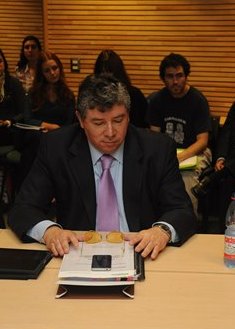


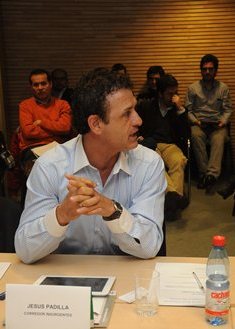
Photos: Andrés Salata
In the afternoon, Professor Manuel Tironi (Instituto de Sociología, PUC) moderated a dialogue titled “How to increase and improve citizen participation in the design and implementation of integrated BRT systems?” Marco Priego (EMBARQ, Mexico) and Sofia Lopez (Ciudad Viva, Santiago) participated as members of NGOs that have emphasized the need to modify certain aspects of the transportation systems in their respective cities. To provide the perspective of the authorities on these topics, the participants included Jorge Rocha on behalf of Metrobús and Germán Correa, ex-General Coordinator of the project that eventually became Transantiago. Among the conclusions from the roundtable:
- Citizen participation should be included, in a sustained manner, in all project stages.
- To speak of “citizen participation” in the abstract is not useful. We should specify the types of participation being considered and desired and clearly distinguish citizen participation (as an interactive political process) from simple marketing and information provision.
- There is a lack of specialists with experience in organizing citizen participation that can strengthen urban transportation system projects and improve prospects for success.
- Knowing citizens’ actual preferences is necessary to better approximate their behavior (e.g., in models); but such knowledge is insufficient for integrating citizens into the processes of design and implementation. We should also (a) better know their daily non-discursive activities and (b) enable them to participate more directly in decision-making.
- The success of citizen participation (and systems better-aligned with users) depends on recognizing the diversity of users and user profiles.
- We should take advantage of the possibilities for real-time interaction with users/citizens enabled by new communication technologies.

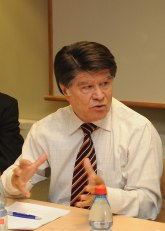

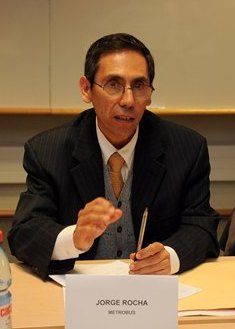
Fotos: Andrés Salata
This workshop was made possible thanks the support of the MIT International Science and Technology Initiatives (MISTI). The material discussed will be analyzed more deeply and serve to further strengthen the research of one of the research groups that participate in the Centre of Excellence ALC-BRT.
Download the full program of the Workshop (in Spanish).
Presentations (in Spanish) by:
Arturo Ardila-Gómez: Transporte y sustentabilidad política.
Christopher Zegras: Metrobús: BRT en Ciudad de México.
Manuel Tironi: Transantiago: Objetivos, Características y Desafíos.

Photo: Andrea Villena
¿Comments? ¿Opinions? ¿Similar News? Send them to us!
Tweet
Event Wrap Up: Transantiago and Metrobús – How to achieve social sustainability? (in Spanish)

Reformar profundamente un sistema de transporte urbano es tan complicado como construir una casa con los habitantes dentro. A pesar de todas las fallas que puedan atribuirse al status quo, lo cierto es que tanto los operadores transportistas como los usuarios se adaptan a las condiciones del mercado en el que operan, por lo que cualquier modificación debe realizarse con sumo cuidado. En otras palabras, los grandes planes para mejorar el transporte urbano en nuestras ciudades deben buscar un equilibrio entre lo técnicamente deseable y lo políticamente posible. Cargar la balanza de un solo lado puede descarrilar la implementación de la reforma, o debilitarla de tal manera que no genere los resultados esperados. Aunque no son los únicos, hay dos temas críticos a considerar en la búsqueda de este equilibrio: La forma en que los implementadores abordan la negociación o incluso el conflicto con los operadores pre-existentes, y la manera en que comunican y abren el proyecto a la participación de la sociedad en general. Ambos temas inciden no solamente en la factibilidad de implementar la reforma, sino además en la sostenibilidad del sistema una vez que está en marcha.
Con esto en mente, el nuestro Centro de Excelencia, junto al Instituto de Sociología de la Pontificia Universidad Católica de Chile y el Department of Urban Studies and Planning de MIT, convocó a un grupo diverso de especialistas, funcionarios, empresarios y representantes de la sociedad civil para dialogar y compartir las lecciones resultantes de la implementación del Transantiago en la capital chilena, y del Metrobús en la Ciudad de México. El evento se realizó el pasado Jueves 31 de Mayo en las instalaciones de la Pontificia Universidad Católica de Chile, y fue inaugurado por el Ministro de Transportes y Telecomunicaciones de Chile, Pedro Pablo Errázuriz.
El diseño del evento pretendió privilegiar las conversaciones sobre las ponencias oficiales. Por la mañana tanto autoridades como operadores de ambos sistemas dialogaron en una mesa moderada el Profesor Christopher Zegras, de MIT. Participó Jesús Padilla, Presidente de Corredor Insurgentes (principal operador privado del Sistema Metrobús), así como Simón Dosque y Hector Moya (Gerentes de Buses Vule y Subus Chile, respectivamente). Por parte de las autoridades, nos acompañó el Director de Planeación y Evaluación del Metrobús, Jorge Rocha, así como Carolina Simonetti, de la Coordinación General de Transantiago. Entre las conclusiones que podemos destacar están las siguientes:
- Los sistemas más exitosos son los que logran transitar de un esquema de confrontación (autoridades vs empresarios) a un esquema de colaboración y confianza.
- La incorporación de transportistas tradicionales como operadores de BRT es quizás necesario, pero implica un proceso complicado (de construcción de consenso hacia el interior de las organizaciones y de negociación de los términos del contrato) que sin duda incrementa los costos del proyecto.
- Este tipo de proyectos ofrece una oportunidad para transitar de un sistema de organización basado en gremios a un sistema basado en empresas. Esta transición puede ser dolorosa para algunos actores y genera perdedores, pero promete menos externalidades negativas (accidentes, congestión, contaminación) y quizá un mejor servicio para el usuario.
- Los acuerdos generados con operadores para la etapa inicial del proyecto deben ser lo suficientemente flexibles como para ser adecuados a condiciones que pueden cambiar tras la implementación.
- Es vital fortalecer a las contrapartes (autoridades y empresarios) que están más comprometidos con el éxito de la reforma. En ambos grupos hay intereses heterogéneos y en ocasiones encontrados, lo que pueden aprovechar los opositores para sabotear el proceso. En el caso de las autoridades, es importante evitar en la medida de lo posible un diseño institucional en el que la toma de decisiones queda subdividida en múltiples sub-unidades, pues dicho esquema fragmentaliza la visión y el ámbito de responsabilidad de cada una.




Fotos: Andrés Salata
Por la tarde, el Profesor Manuel Tironi (Instituto de Sociología PUC) coordinó un diálogo titulado «Cómo hacer más y mejor participación ciudadana en el diseño e implementación de sistemas integrados y BRT?». Participaron Marco Priego (Embarq, Mexico) y Sofía Lopez (Ciudad Viva, Santiago), miembros de ONGs que han planteado la necesidad de modificar ciertos aspectos de los sistemas de transporte en sus respectivas ciudades. Para dar la visión de las autoridades sobre estos temas, estuvo nuevamente Jorge Rocha por parte de Metrobús y Germán Correa, ex-Coordinador General del proyecto que eventualmente se convirtió en Transantiago. Entre las conclusiones de la mesa destacan las siguientes:
- La participación ciudadana debe darse, de manera sostenida, en todas las etapas del proyecto.
- Hablar de «participación ciudadana» en abstracto no ayuda de mucho. Debemos concretizar de qué tipo de participación ciudadana estamos hablando y para qué la queremos, así como distinguir claramente entre participación ciudadana (como proceso político e interactivo) y simple marketing y entrega de información.
- Existe una carencia de especialistas que apoyen el desarrollo de modernizaciones de sistemas de transporte público, con una participación ciudadana que fortalezca y factibilice la implementación del proyecto.
- Conocer las preferencias declaradas es necesario para aproximarse más y mejor a la naturaleza de los usuarios, pero no es suficiente para integrarlos al proceso de diseño/implementación. Se debe también (a) conocer sus practicas cotidianas no-discursivas, y sobre todo (b) hacerlos partícipes directamente en toma de decisiones.
- El éxito de la participación ciudadana (y de sistemas sintonizados con los usuarios) depende de reconocer que existe una diversidad de usuarios/perfiles y no un usuario único.
- Debemos aprovechar las posibilidades de interaccion en tiempo real otorgadas por las nuevas tecnologías.




Fotos: Andrés Salata
Este seminario fue posible gracias al financiamiento del programa MIT International Science and Technology Initiatives, MISTI. El material discutido será analizado a mayor profundidad y servirá para nutrir a uno de los equipos de investigación que participan en el Centro de Excelencia ALC-BRT.
Baja el programa completo de la actividad.
Presentación de Arturo Ardila-Gómez: Transporte y sustentabilidad política.
Presentación de Christopher Zegras: Metrobús: BRT en Ciudad de México.
Presentación de Manuel Tironi: Transantiago: Objetivos, Características y Desafíos.

Foto: Andrea Villena
¿Comments? ¿Opinions? ¿Similar News? Send them to us!
Tweet
Bus Rapid Transit wanted in ACT

Source: Australasian Bus and Coach
A survey has shown more than 65 percent of Canberra residents want a rapid transit corridor between Gungahlin and Civic, according to government.
Environment and Sustainable Development Minister Simon Corbell says the survey, which sampled 1000 residents, shows about two thirds of the population want Bus Rapid Transit (BRT) or Light Rail Transit (LRT).
«While Light Rail Transit was chosen over Bus Rapid Transit by 68.5 percent of people surveyed before knowing the cost of each project, this figure fell to just under half (45.8 percent) with the preference for Bus Rapid Transit rising to about the same level (46.5 percent) once the likely costs were revealed,” Corbell says.
Corbell says the survey shows about 12.5 percent of respondents believe current public transport is acceptable.
Corbell says 32.3 percent of respondents cite environmental benefits as the main reason for prefering LRT, while 26.8 percent of people largely prefer BRT because of familiarity with bus transport.
Corbell says 14.9 percent of respondents believe BRT will be cheaper to build and maintain, 14.3 percent think it will be quicker to build and implement, and 10.3 percent believe it will be compatible with existing systems.
He says 9.7 percent also think buses could move around obstructions more easily, and 8.5 percent believe a BRT will be less intrusive.
«The survey also found that public transport improvements in the City to Gungahlin corridor were supported across the whole city – Inner South (60.6 percent), Woden-Weston (61.2 percent), Tuggeranong (61.9 percent), Inner North (65 percent), Gungahlin (70.0 percent), and Belconnen (70.3 percent),” Corbell says.
Corbell says more than 750 people attended information sessions about the project during the past three weekends at Dickson, Civic and Gungahlin and a further 560 people had completed an online survey.
Corbell says the survey was conducted by an independent consultant.
¿Comments? ¿Opinions? ¿Similar News? Send them to us!
Tweet
Video: Jaime Lerner talks about Public Transport in Latinamerica (in Spanish)

Source: SIBRT
El Presidente Honorario de SIBRT, Jaime Lerner, propuso en su mensaje seguir trabajando por la mejora sustancial de los sistemas de movilidad en buses en las ciudades latinoamericanas. Destacó la importancia de tener sistemas de alta calidad que responda a las necesidades de la gente para no depender del carro privado.
¿Comments? ¿Opinions? ¿Similar News? Send them to us!
Tweet
Event wrap up: XIX Conference of Urban and Suburban Transport in Mexico

Matías Fernández, member of our Centre of Excellence and researcher at the Institute of Sociology, Pontificia Universidad Católica de Chile, was invited to speak at the XIX Convención de Transporte Urbano y Suburbano (Conference of Urban and Suburban Transport), which took place at Puerto Vallarta, Mexico, on June 6, 7 and 8, 2012. In a Panel with representatives from Embarq-Mexico, Matías Fernández talked about «Political processes in the transition to BRT systems: the cases of Transantiago (Santiago, Chile) and Metrobús (Mexico City)». Between the audience there were transport leaders from all cities and states of Mexico, who nowadays are either participants or interested parties in several transport reforms in different cities of the country. For this reason, the presentation emphasized the weaknesses and strengths of the Transantiago experience: a system designed from a purely technical standpoint, excluding proper information, negotiation and participation processes –with dramatic consequences– but achieving a fully integrated transport system for the entire city of Santiago in a very short period of time.
Arisen from the contrasts between Metrobús and Transantiago experiences, the researcher proposed to seriously discuss the following questions: Is it possible to reconcile graduality with integrity in public transportation systems’ reforms? Which are the costs and benefits of the lack of participation and information processes in Mexico and Chile? Which consequences have had the negotiation processes in both cities?
The numerous differences between Metrobús and Transantiago, the researcher hypothesizes, would come from different ways of doing politics in both countries, and he draw attention to agents involved in design and implementation of BRT systems to properly consider the political dimension as a constitutive aspect of the possibilities and limitations of reforms to public transport systems in Latin American cities.
Download the full conference program (in Spanish).
¿Comments? ¿Opinions? ¿Similar News? Send them to us!
Tweet
Press Release by EMBARQ: New Traffic Safety Guidelines Can Save Lives on Bus Corridors Worldwide

Source: EMBARQ
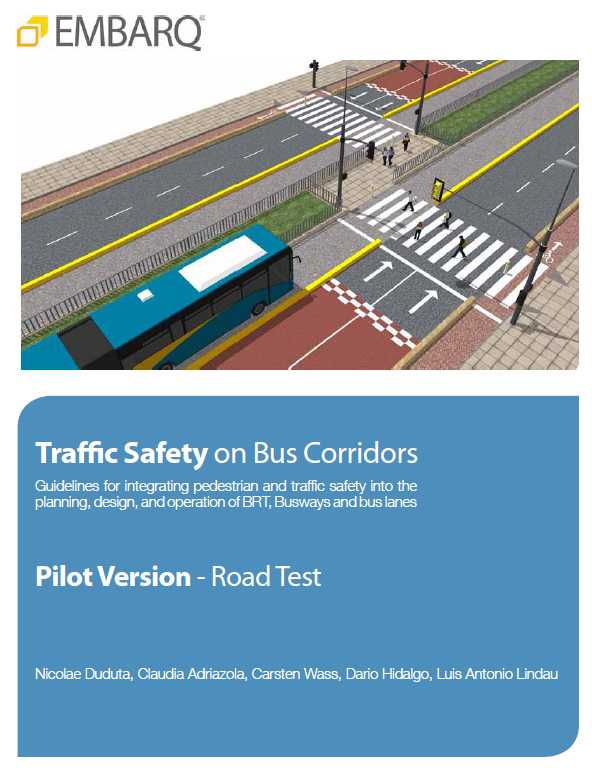
WASHINGTON (May 30, 2012) – Each year, 1.2 million people die in traffic crashes, according to the World Health Organization, and traffic fatalities are projected to become the fifth leading cause of premature death worldwide by 2030, ahead of HIV/AIDS, violence, tuberculosis, or any type of cancer. One way to prevent many of these deaths and injuries is to improve traffic safety, especially on major bus corridors in cities. EMBARQ, the World Resources Institute’s center for sustainable transport, today released the draft “Traffic Safety on Bus Corridors” guidelines to improve traffic safety on bus corridors worldwide. Based on more than two years of research, the guidelines are part of the Road Safety in 10 Countries (RS10) project, funded by Bloomberg Philanthropies.
“This guidebook is part of a broader effort by EMBARQ to illustrate how sustainable transport projects can greatly improve traffic safety, and ultimately, save lives and improve quality of life for people around the world,” said Holger Dalkmann, director of EMBARQ.
The guidelines are based on findings from a two-year research project, led by EMBARQ, which evaluated safety, operations and accessibility on major bus corridors and bus rapid transit (BRT) systems in 18 cities around the world. Key findings show:
- Pedestrians account for the majority of fatalities across all bus corridors;
- Safety on BRT and bus corridors depends on the overall design of the street and not just the bus infrastructure;
- Center-lane BRT corridors with closed stations are the safest design option;
- Counterflow, when buses drive in the opposite direction of mixed traffic, is the most dangerous type of configuration for a bus corridor; and
- The most common types of vehicle collisions in BRT systems occur when cars make illegal left turns across bus lanes and collide with oncoming buses.
“BRT and bus routes are often located on major urban roads, which have the highest concentration of traffic crashes in cities,” said Claudia Adriazola, director of EMBARQ’s Health and Road Safety program. “A new BRT system can attract a lot of pedestrians to these areas, so it is crucial to help cities understand how to maximize safety for everyone on the road.”
The purpose of the draft planning and design guidelines is to provide bus agencies, local jurisdictions, and regional and international organizations with a set of suggested design, planning, and operational criteria for bus systems, including BRT corridors. The guidelines include recommendations for street design, intersections, stations, and station access, as well as transfers and terminals.
“Data has shown that after the implementation of some BRT systems, such as TransMilenio in Bogota or Macrobus in Guadalajara, crashes and fatalities on these corridors dropped by as much as 50 percent,” said Dario Hidalgo, director of EMBARQ’s Research and Practice, member of our Centre of Excellence and an author of the guidelines. “Not all bus systems have had a positive impact on safety, and in some cases, there is still considerable room for improvement, which is why EMBARQ developed these guidelines to improve traffic safety.”
The research included iconic BRT systems in places like Curitiba and Bogota, Colombia, megacities Mexico City and Rio de Janeiro, as well as examples from New Delhi and Ahmedabad, India, and Brisbane, Australia.
“Our research shows that the design of a bus corridor can have a significant influence on the frequency of crashes on the street,” said Luis Antonio Lindau, president of EMBARQ Brazil and member of our Centre of Excellence, who contributed to the research.
During the next six months, experts are invited to provide feedback on the content, methodology, feasibility, and usefulness of the safety recommendations. The feedback will be incorporated into the final version of the guidelines, to be released in 2013.
To participate in the “road test,” please contact EMBARQ Transportation Research Analyst Nicolae Duduta at nduduta@wri.org.
Download full report:
English
Español
Português
¿Comments? ¿Opinions? ¿Similar News? Send them to us!
Tweet
Video: interview to our Director, Juan Carlos Muñoz (in Spanish)

Check out the video, where Juan Carlos Muñoz analyzes the following situations currently happening in Santiago:
- Metro de Santiago demand during peak hours
- Changes in Transantiago’s operators contracts
- Costanera Center opening
¿Comments? ¿Opinions? ¿Similar News? Send them to us!
Tweet
Opinion Pieces: The number of people using train services in the peak suggests that BRT should (must) have a real future

Opinion Pieces: since 2007, Prof. David Hensher has written an opinion column in the Australasian Bus and Coach magazine, where he monthly discusses a lot of different transport-related hot topics. In this section we are revisiting these columns.
August 2011
One of the main arguments used to support rail investment over bus systems is the carrying capacity of trains per hour. We are told that bus rapid transit (BRT) could never provide the service capacity required to offer an alternative to heavy rail investment. What is the evidence? We look at the recent figures provided by CityRail in Sydney.
The one hour morning peak to the city as measured at various stations for the nine metropolitan lines (excluding the Blue Mountains and the Central Coast) shows a maximum of 17,280 passengers on the Western line passing through Redfern Station (a station next to Central). The next highest patronage is 16,905 on the Illawarra line at Sydenham, followed by 16,680 on the North Shore line passing through St Leonards Station. The patronage drops off very fast, down to 11,735 per morning peak hour on the Airport and East Hill lines, with the remaining lines having patronage levels at surveyed locations between 9,615 and 3,810. The best in the afternoon peak from the city is 15,240 passengers counted at Redfern on the Western line.
With this factual evidence, let us note that many of the BRT systems (including Brisbane busway system) already have up to 10,000 passengers per hour (see graph below), which covers peak patronage levels for all but four of the nine lines in Sydney, with growing evidence that BRT can accommodate all patronage levels currently observed on the entire CityRail network.
Food for thought
¿Comments? ¿Opinions? ¿Similar News? Send them to us!
BRT basic concepts – video

Developed by EMBARQ Brasil
¿Comments? ¿Opinions? ¿Similar News? Send them to us!
Tweet
Cities in focus | Mexico City Metrobús

Source: EMBARQ
In 2002, EMBARQ founded CTS-México—a Mexican nongovernmental organization staffed with transport engineers, urban planners, and policy experts—and partnered with the Mexico City government to develop a bus rapid transit (BRT) corridor on a high-profile avenue running through the heart of the Mexican capital. The system has reduced emissions, improved mobility, and reduced travel times.
Producer: EMBARQ
Director: Dave K. Cooper
Executive Producer: Ethan Arpi, Rhys Thom
Editor: Emily Calderone
Music: Avenarius
¿Comments? ¿Opinions? ¿Similar News? Send them to us!
Tweet
Transmetro recovered 7.462 m2 of public space (in Spanish)

Esto fue posible gracias al trabajo coordinado entre la Alcaldía Distrital y el Sistema de Transporte Masivo, que invirtió 2 millones de dólares y apoyó la gestión de los acuerdos para lograr el traslado de los comerciantes del sector.
Source: SIBRT
Con la puesta en marcha de Transmetro en la ciudad de Barranquilla, Colombia, se inició un proceso que no sólo tenía como objetivo ofrecer a los ciudadanos una opción de transporte con comodidad, seguridad y calidad, sino también, la recuperación de espacios vitales para la convivencia de la comunidad.
Así fue como, desde la construcción del Sistema de Transporte Masivo en sus inicios, se pensó en devolverle a la ciudad vías y espacios que estaban invadidos por vendedores y particulares que incumplían las normas determinadas por las autoridades.
El pasado mes de abril, los habitantes de Barranquilla vieron con mucha complacencia cómo en un reconocido centro comercial del sur de la ciudad se recuperaron 7.462 metros cuadrados de andenes que habían sido invadidos desde hace más de 15 años. Esto fue posible gracias al trabajo coordinado entre la Alcaldía Distrital y el Sistema de Transporte Masivo, que invirtió 2 millones de dólares y apoyó la gestión de los acuerdos para lograr el traslado de los comerciantes del sector.
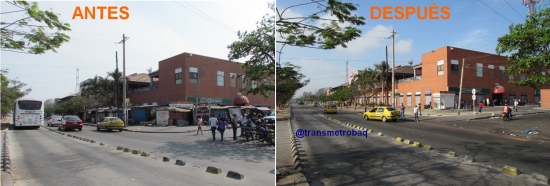 La nueva imagen despejada del centro comercial y la reubicación de 193 vendedores hacia un nuevo lugar con todos los servicios públicos y la infraestructura necesaria, fue el resultado de un proceso de más de 6 años. Durante este tiempo, fueron escuchadas las sugerencias de los vendedores quienes, además, recibieron formación en temas como atención al cliente y manejo adecuado de sus productos, gracias al convenio con una institución de educación nacional – Sena-.
La nueva imagen despejada del centro comercial y la reubicación de 193 vendedores hacia un nuevo lugar con todos los servicios públicos y la infraestructura necesaria, fue el resultado de un proceso de más de 6 años. Durante este tiempo, fueron escuchadas las sugerencias de los vendedores quienes, además, recibieron formación en temas como atención al cliente y manejo adecuado de sus productos, gracias al convenio con una institución de educación nacional – Sena-.
La noticia tuvo gran impacto en toda Colombia como se pudo constatar en las redes sociales, toda vez que en Twitter la palabra Metrocentro –nombre del centro comercial- fue “trending topics” el día de la reubicación de los vendedores y en Facebook la foto con el área despejada tuvo más de 2.500 “me gusta” y fue “compartida” más de 500 veces. Esto demuestra que los ciudadanos cada vez son más conscientes de la importancia que tienen estos procesos para el desarrollo de las ciudades, a partir de la implementación de los Sistemas Masivos de Transnporte.
¿Comments? ¿Opinions? ¿Similar News? Send them to us!
Tweet
Opinion Pieces: Tunnel Vision

Opinion Pieces: since 2007, Prof. David Hensher has written an opinion column in the Australasian Bus and Coach magazine, where he monthly discusses a lot of different transport-related hot topics. In this section we are revisiting these columns.
July 2011
A hot topic in Sydney is tunnels. Not tunnels, for cars but finding the many unused or improperly used tunnels under Sydney’s Central Business District. In a recent article I wrote of opportunities to ‘solve’ some of Sydney’s surface chaos in York Street where buses from the northern side of Sydney all converge after crossing the Harbour Bridge. In addition to buses that are actually in service, we have a number of buses ‘not in service’ due to the need to be repositioned under the contract arrangements in place. Indeed one strong message from the chaos is the restrictions that the current contract arrangements have in limiting the fuller use of the service capacity entering and leaving the CBD.
Why can we not put the bus station underground, with access soon after coming across the Bridge and just before entering the York Street precinct? Especially since we believe that there is a tunnel system in place that was designed for the railway in the Bradfield era but never used for that purpose, which recently has become a long car park. It makes very good sense, since we simply have run out of surface ideas to solve this problem.
The suggestion that we can rid of the buses by introducing light rail into the CBD is simply not tenable, unless light rail goes across the harbor bridge and extends well into suburbia. What people hate is a transfer, especially between two public transport modes, and that will be required if light rail is built and used to remove many of the bus services in the CBD.
So let us encourage a consideration of a substantial underground bus terminal with efficient lifts to and from the surface in an environment in which the air is protected from emissions and which will enable the CBD to do some nice pedestrian and bike solutions on the surface. There appears to be a growing interest in this from some stakeholders and I encourage all stakeholders with influence to promote this idea.
Food for thought
¿Comments? ¿Opinions? ¿Similar News? Send them to us!
Tweet
Eclipse Bus Rapid Transit Network launched

Source: Eurotransport Magazine
Phase one of the new Eclipse Bus Rapid Transit (BRT) busway, which connects Fareham and Gosport (England), was officially launched on 25 April.
Serving both residential and business areas in Fareham, Gosport and the Gosport peninsula, the development of the BRT scheme has been designed to ensure that bus journeys are more punctual and reliable, avoiding the problems that can be created by traffic congestion.
The dedicated Eclipse BRT busway has been constructed between Redlands Lane and Tichborne Way using what was a former railway line. Its purpose is to enable buses to bypass normal traffic, travelling quickly and easily through a very congested part of the county.
A fleet of 14 brand new, high specification buses, has been specially commissioned and will be operated by local transport provider First. This fleet will provide a dedicated, fast and frequent service on the Eclipse bus rapid transit network. Services E1 and E2 connect Fareham and Gosport providing regular travel opportunities for those wishing to get to and from the thriving shopping areas in each town, while also connecting with rail and ferry services and other bus services in the area, making it easy for people to interchange with other forms of transport. In addition Service 88, an existing bus route connecting the two towns, will also use the busway at peak times, avoiding the traffic congestion that can build up on the A32 approaching Fareham and helping to reduce journey times for peak time commuters.
Where Services E1 and E2 buses leave the dedicated busway and travel on-road, meeting normal traffic, the array of bus priority measures that have been put in place along the routes means that Eclipse buses can easily sail past other vehicles caught in traffic jams. This is particularly notable at the junctions between the A27 and Redlands Lane and the junction between the A32 and Tichborne Way.
Councillor Mel Kendal, Executive Member for Environment and Transport, at Hampshire County Council says: “We are committed to bus rapid transit in south east Hampshire and understand what it needs to offer in order to change perceptions of its value and benefits. Completion of the scheme demonstrates the significant investment that we, with the Government’s help, are making in transport infrastructure to enable improved public transport alternatives and reduce reliance on the car. Although I appreciate that, for some, it will be a big step to leave the car and travel by bus, the combination of reliable journey times and top quality buses with Wi-Fi as well as on-board, real-time travel information, are persuasive and convincing reasons to do so.”
Marc Reddy, Regional Commercial and Business Growth Director for First in the South West and Wales, says: “This is an exciting day for bus users in Hampshire. The launch of the Eclipse network delivers significant benefits for local people. The new routes, the improved infrastructure that supports them and the brand new, state of the art buses operating on them, offer people in Gosport and Fareham a real alternative to other forms of transport, making it much easier for them to travel around the area for work or pleasure. We are thrilled to have been able to work with Hampshire County Council to deliver this project and look forward to carrying many thousands of people in the months and years to come.”
The majority of funding for the busway came from a £20 million Government grant. The first Eclipse Bus Rapid Transit passengers travelled on Sunday 22 April when vehicles started running along the dedicated route.
This first phase of the Eclipse BRT network brings numerous immediate benefits to the area. Bus users in Gosport and Fareham now have access to:
- 14 brand new, specially designed buses, all complete with individual leather seats, wood effect flooring, free Wi-Fi, on-board infotainment screens providing real time bus information, local train and ferry departures, and both audible and visual “next stop” bus announcements.
- More frequent services: buses will run up to every seven minutes along the busway.
- 14 brand new bus stops on the busway, with enhanced facilities for customers. They include large shelters, comfortable seating, plenty of lighting, real time information screens, CCTV for added security and additional measures to improve accessibility for disabled users for example blind and partially sighted bus users in possession of special key fobs (being provided by Hampshire County Council) will be able to access audio announcements at key bus stops on demand.
- A number of other upgraded bus stops at key locations in the region, for instance at Fareham and Gosport bus stations, Fareham rail station and Creek Road in Gosport. The stops will offer customers similar facilities as the stops along the busway itself, while elsewhere a number of other stops have been refurbished, incorporating QR codes within the stop that users will be able to scan with their mobile phones to access real time bus information.
- Secure 24/7 real-time CCTV monitored cycle parking is provided on the busway near the junctions of Redlands Lane, Palmerston Drive, Wych Lane and Tichborne Way, giving customers the option of cycling to and from BRT stops before using the Eclipse buses to complete their journeys. Notably cyclists can also use the busway themselves.
For more information about First in Hampshire and Dorset, or to view, download or personalise timetables for those routes using the new BRT busway, log onto: www.firstgroup.com/hampshire.
A dedicated website has also been created to support the Eclipse BRT. This contains real time bus information for the services operating on the busway. It can be found at: www.eclispebus.co.uk
¿Comments? ¿Opinions? ¿Similar News? Send them to us!
Tweet
The New Kid on the Block: Metrobus Opens Line 4 in Mexico City

Source: The City Fix by Dario Hidalgo*
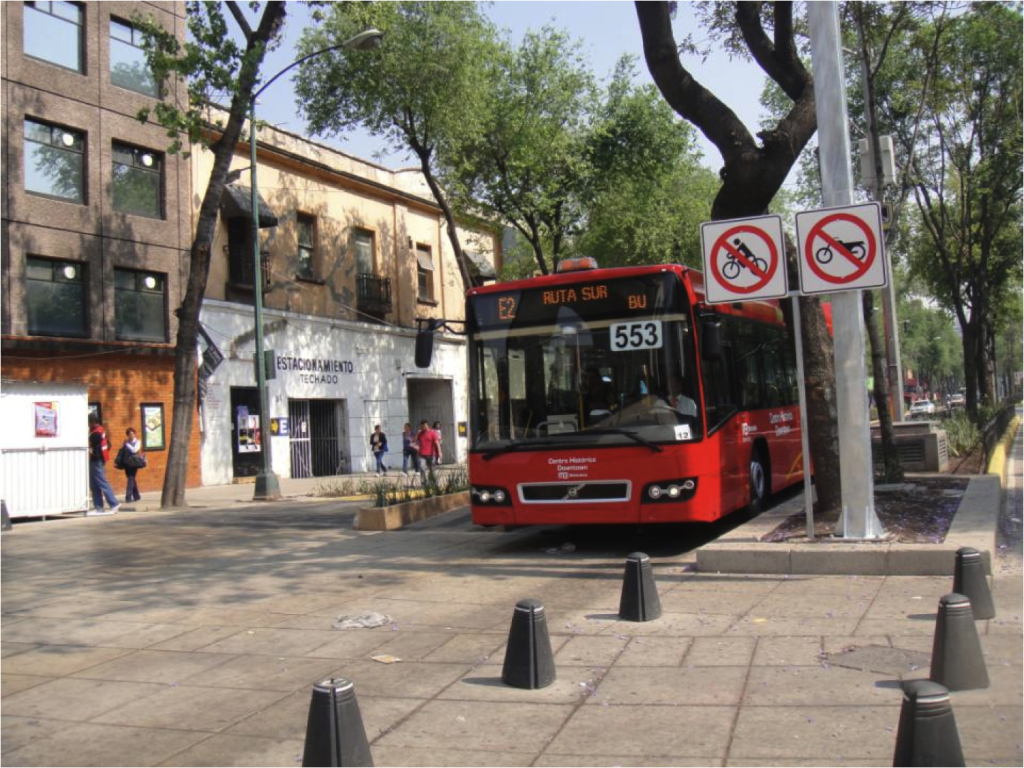
Downtown streets in Mexico City’s Historic District were totally rebuilt to provide safe transit for the new buses and help recover the urban environment. Photo by EMBARQ Mexico.
Mexico City now has a new bus service running through the heart of the Historic District, with service to the international airport. Metrobus Line 4, which opened on April 1, shows ingenuity and exemplifies the core characteristic of bus-based transit systems: being flexible.
When the city started planning for the corridor criss-crossing through downtown, EMBARQ Mexico helped them in two ways: suggesting adequate designs for narrow streets and considering pedestrian safety as a top concern. The technical team provided information about narrow corridors in the historic centers of Quito and Guayaquil, Ecuador, and Bogota, Colombia, where bus rapid transit (BRT) had already been implemented. When the designs were advanced, EMBARQ conducted a road safety audit, reviewing the designs and locations of the planned BRT corridor and making recommendations on how to make the transport systems safer for users. The audit was led by consultant Carsten Waas and EMBARQ Transportation Research Analyst Nicolae Duduta. Many of the recommendations were adopted, thereby improving several intersections. During the implementation phase, EMBARQ Mexico also provided designs for signage.
The circular line uses low-floor, 12-meter buses, an innovation from the high-floor, articulated 18-meter buses used in Lines 1, 2 and 3. Its air conditioned fleet of 46 Diesel Euro V buses and eight hybrid buses are considered to be the most advanced in the region. Fare collection is on board, for a change, using smart cards and integrated with the rest of the bus and metro network. The addition of air conditioning, advanced engines and on-board ticketing shows that it is always possible to innovate and stay ahead with technology.
But the nicest part of the system is not the buses. It is the immense care in designing bus infrastructure in a challenging environment. Downtown Mexico City is a jewel of colonial architecture, with narrow streets and beautiful buildings. It also has some areas that have deteriorated over the years. The implementation of the new bus line helped recover some of the most dreadful streets in the Historic District, with wall-to-wall interventions, adapting its design to changing conditions along the route.
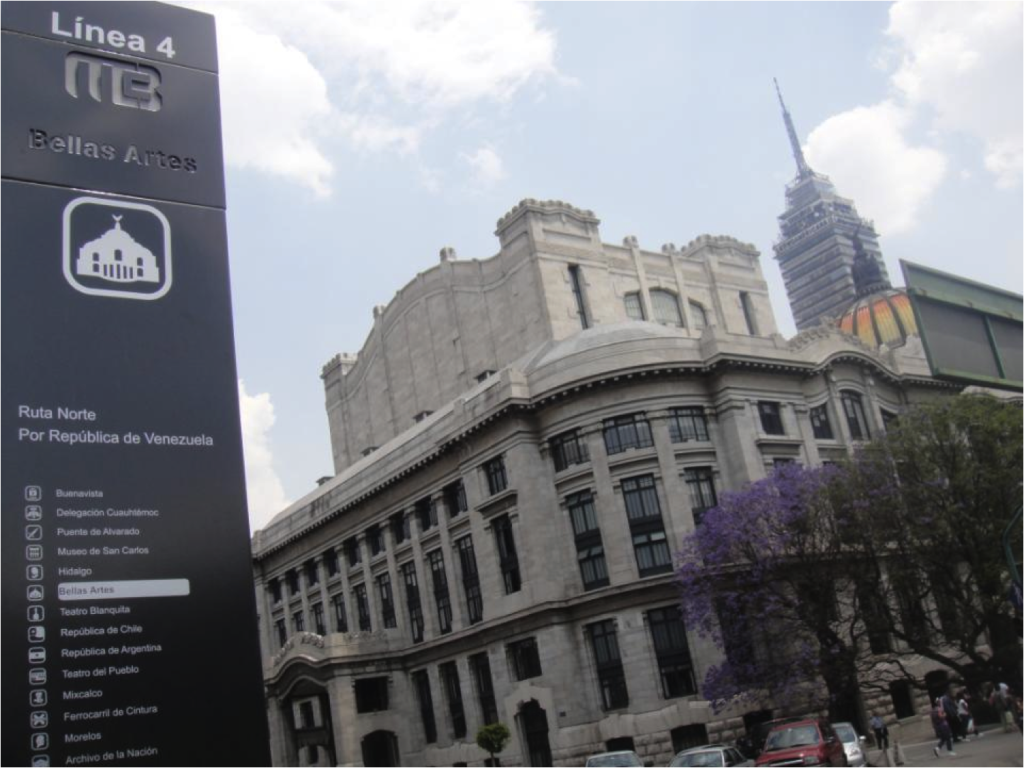
A totem at Bellas Artes Station, showing three Mexico City icons together: the Fine Arts Theater, the Latin American Tower, and Metrobus. Photo by EMBARQ Mexico.
Metrobus joins Quito and Guayaquil, Ecuador; and Pereira and Bogota, Colombia, in using downtown narrow streets exclusively for buses and pedestrians—not an easy task due to the worries of local merchants and parking operators. The design also needed to pass the tough requirements of the Historic Center Authority, which has been working over decades to recover the heart of Mexico City.
One interesting feature of the new line is the extended service to the international airport, providing passengers and workers access to an attractive and cheaper alternative to connect. It is amazing to see the buses “flying” through the dedicated bus lanes to the airport, while the cars and taxis are stuck in the gridlock of Mexico City, which has been ranked worst for car-commuter “pain” in the latest survey by IBM that ranks 20 world cities for the best and worst commutes.
REMARKABLE HISTORY
With the launch of Metrobus in 2005, Mexico showed, against all odds, that it was possible to dedicate lanes to buses on the longest avenue in Latin America, Avenida Insurgentes. In just a few short years, it grew its bus system from 20 kilometers in 2005 to 95 kilometers in 2012. Now it shows us that BRT concepts are flexible enough to cater to the challenging environment of the Historic District in the third largest megacity in the world. The new addition of Line 4 places Mexico City ahead of other cities in Latin America when it comes to the total length of bus corridors, exceeding the 84-kilometer system of Bogota and the 75-kilometer system of Curitiba—a city known for being the birthplace of BRT.
Mexico’s mass transit systems combined now boast 309 kilometers and cater to 5.8 million passengers every day. In Mexico City, alone, there are 214 kilometers of metro and light rail lines, built between 1968 and 2000. In addition, the neighboring State of Mexico has two BRT corridors (Mexibus), and there is a 27-kilometer suburban rail line, which opened in 2008.

Line 4 operates in a challenging environment of narrow historic streets. Photo by EMBARQ Mexico.
CHALLENGES AHEAD
The toughest challenge of Metrobus Line 4 was to implement bus services in a 10-meter wide right-of-way, including the sidewalks. Another challenge was dealing with the high pedestrian activity in this commercial, institutional, cultural and touristic hub. The design is full of elements to protect and provide clear guidance to pedestrians, but there is still a lot to improve, especially since jaywalking is a way of life in this part of the city.
Other features that need improvement are the programming of traffic lights and communications to potential users. Since the corridor does not have traffic signal priority, passengers are losing a lot of time at intersections. On the other hand, many potential users are not aware of the new service, including those arriving on the suburban rail line at Buenavista at the western edge of downtown.
EMBARQ Mexico, under the leadership of transport systems expert Marco Priego and other members of the technical team, provided continued support to the local government in the design and implementation of the new line. This was critical for the initial approval of the project, as there was skepticism about the possibility of running a BRT on such narrow streets. Several design elements in the stations, including the iconography of signage, were the result of EMBARQ Mexico’s recommendations. EMBARQ also provided a road safety audit, and about half of the recommendations were included in the final design.
Now that the system is in operation, EMBARQ Mexico has provided a review, highlighting additional aspects of the system to improve. Road safety, especially, can be enhanced through design, driver training and user education.
Congratulations to Mexico on this new achievement!
*With input from Marco Priego.
¿Comments? ¿Opinions? ¿Similar News? Send them to us!
Tweet
SIBRT: "High Quality Urban Public Transportation for All"

Second annual conference promotes development of urban public transport in Latin America.

The Second Annual SIBRT Congress of Best Practices in Latin America was held on April 25-26 in the city of Leon, Mexico.
The event brought together more than 350 transport experts from 15 countries, convened by the Latin American Association of Integrated Transport Systems and BRT (SIBRT) and EMBARQ.
The Congress was sponsored by 21 companies from a range of related industries, many of which expressed their interest in expanding their relationship with SIBRT and the EMBARQ Network; as a start, becoming strategic allies of SIBRT. There were 6 Gold sponsors: DINA, Pagobus, ACS, Andina Technology, Empresa1, Inteligensa; three Silver Plus: Volvo, GMV, Servyre; and twelve Silver sponsors: Caliper, Doppelmayr, Hersan, Trapeze, BEA, Transconsult, InterBerica, Grupsa, Nettropolis, Hyundai, Régie T, Bioplast. Three of these sponsors have decided to become strategic allies of SIBRT (Doppelmayr, Hersan, MAN) and many others are evaluating the possibility.
During the two-day conference, 28 lectures focused on four central themes: Public Policies for Sustainable Transportation, Modernization and Financing of Public Transport, Road Safety, and Quality of Service and User Satisfaction.
Participants included directors and technical staff from 19 agencies that manage integrated transport and BRT systems in countries like Brazil, Colombia, Chile, Ecuador, Paraguay, Peru and Mexico. Transportation managers and decision makers from Argentina, Bolivia, Botswana, Canada, the United States, Spain and Guatemala also had the opportunity to learn best practices of Latin America transit systems. Representatives of bus systems operators also attended, including Otavio Cunha, president of the NTU, which is the national association of Brazilian bus system operators.
Here are some key takeaways from the main speakers:
Luis Aparicio Gutiérrez, EMBARQ’s Latin America Strategic Director and Executive Secretary of SIBRT, stressed the need to integrate policies for mobility and urban development, and to prioritize high-quality «door to door» transport solutions for all.
«We need to prioritize the recovery of public spaces for people and for non-motorized transport,” he said. “We must prioritize the use of technology and clean fuel, and reduce inequality.”
Fernando Paez, former president of SIBRT and former director of the Transmilenio in Bogota, Colombia, stressed the importance of developing the institutional capacity, including financial mechanisms, to put policies into practice.
Claudio Varano, an expert in pre-paid fare systems, said “the quality of service on integrated systems and BRT should be subject to constant monitoring.”
Salvador Herrera, deputy director of EMBARQ Mexico, said resource management should begin from a solid institutional structure and planning.
Jorge Jara, director of EMBARQ Andino, focused on the need to save lives. «We can improve in many ways, especially in regards to standardizing and updating traffic crash records, developing auditing committees to improve road safety, and improving the design of infrastructure, with a focus on safety and conducting traffic education programs.”
Monica Vanegas, former director of Megabus, the entity that manages the transportation system of the city of Pereira, Colombia, presented on branding and marketing, saying that the focus of transportation projects should be on people.
«Marketing, media relations, and user education are three aspects that are relevant to the planning, implementation and operation of integrated transport and BRT,» she said. «It is necessary to understand the feedback from dissatisfied users to seek real, deep and appropriate solutions,» she said. «Communication in transportation projects must be grounded in transparency and honesty. And never promise something that cannot be fulfilled.”
¿Comments? ¿Opinions? ¿Similar News? Send them to us!
Tweet
Accidents on Ahmedabad 'killer road' go down: Study

Source: Daily News & Analysis India
Photo: Wikipedia by Amcanada
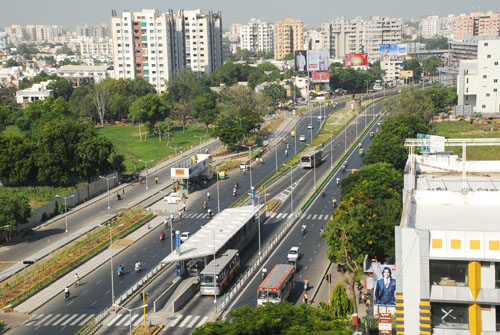 It seems the Bus Rapid Transit System (BRTS) has not only introduced a faster mass transport system with improved infrastructure but also systemized road traffic in Ahmedabad. If statistics of road accidents released in a Centre for Environmental Planning and Technology (CEPT) University study are to be believed, the number of accidents has gone down in stretches like Narol-Naroda in eastern Ahmedabad, earlier known as ‘killer road’.
It seems the Bus Rapid Transit System (BRTS) has not only introduced a faster mass transport system with improved infrastructure but also systemized road traffic in Ahmedabad. If statistics of road accidents released in a Centre for Environmental Planning and Technology (CEPT) University study are to be believed, the number of accidents has gone down in stretches like Narol-Naroda in eastern Ahmedabad, earlier known as ‘killer road’.
According to statistics sourced from the Ahmedabad Traffic Department by Cept, at least 4 persons lost their lives in road accidents on the Narol-Naroda stretch every month – a total of 47, in 2006. The BRTS was introduced in the Narol-Naroda route towards the end of 2010, when two people were killed every month on the stretch. For the year, 24 people were reported dead in road accidents.
The study says the number of fatal accidents in 2011 has come down by 50%, as 12 people died in road accidents in 2011.
The number of serious accidents in the Narol- Naroda stretch in 2006 was 18, 9 in 2010 and 11 in 2011. The total number of accidents on the stretch has thus come down from 183 in 2006 to 151 in 2010 (when BRTS was launched) and 147 in 2011.
HM Shivanand Swamy, associate director at CEPT, said that the reduction in accidents is significant because the number of trucks plying on the Narol-Naroda stretch has not gone down.
«Around 30% of accidents on the stretch happen because of trucks. Despite the number of trucks remaining the same, accidents have gone down,» he said.
The reasons for fewer accidents could be improved road infrastructure on the BRTS route. Authorities say broad roads and barricades along the BRTS corridor have restricted citizens’ habit of driving on the wrong side and switching sides while driving.
«Now they have, perforce, to take a turn and use traffic junctions. Also, the junctions are well managed by the traffic police deputed there,» said Utpal Padia, executive director of the Special Purpose Vehicle, Ahmedabad Janmarg Limited (AJL).
SM Khatri, Deputy Commissioner of Police (DCP), Traffic, Ahmedabad, said that one of the reasons could also be that because of wide roads along the BRTS route, response time for emergency services has also gone down and so it is possible to provide medical help to accidents victim faster than before.
¿Comments? ¿Opinions? ¿Similar News? Send them to us!
Tweet







